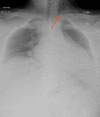Subcutaneous Emphysema Following Tonsillectomy: A Rare Complication of a Common Surgery
- PMID: 38465092
- PMCID: PMC10924276
- DOI: 10.7759/cureus.53825
Subcutaneous Emphysema Following Tonsillectomy: A Rare Complication of a Common Surgery
Abstract
Post-tonsillectomy emphysema is an infrequent yet critical complication that follows tonsillectomy - a prevalent surgical procedure for treating conditions like recurrent tonsillitis and obstructive sleep apnea. While tonsillectomy is generally safe, it is not without risks, including the rare occurrence of postoperative emphysema, where air accumulates abnormally in the neck and head's soft tissues, potentially leading to severe respiratory distress. We present a case of a middle-aged female who underwent tonsillectomy and subsequently developed symptoms indicative of post-tonsillectomy emphysema. Diagnosed through a combination of physical examination and imaging, her treatment involved conservative management and careful monitoring, ultimately resulting in full recovery without the need for surgical intervention.
Keywords: emphysema post tonsillectomy; iatrogenic subcutaneous emphysema; post-tonsillectomy complication; subcutaneous emphysema; surgical emphysema.
Copyright © 2024, Alzamil et al.
Conflict of interest statement
The authors have declared that no competing interests exist.
Figures



Similar articles
-
Exceptional post-tonsillectomy cervicofacial emphysema: A case report.Int J Surg Case Rep. 2024 Jul;120:109866. doi: 10.1016/j.ijscr.2024.109866. Epub 2024 Jun 8. Int J Surg Case Rep. 2024. PMID: 38889514 Free PMC article.
-
Subcutaneous Emphysema as a Complication of Tonsillectomy: Comprehensive Literature Review.Ear Nose Throat J. 2024 Dec 10:1455613241305602. doi: 10.1177/01455613241305602. Online ahead of print. Ear Nose Throat J. 2024. PMID: 39656481
-
Facial subcutaneous emphysema after tonsillectomy.Head Face Med. 2014 Apr 11;10:11. doi: 10.1186/1746-160X-10-11. Head Face Med. 2014. PMID: 24725343 Free PMC article.
-
Clinical Practice Guideline: Tonsillectomy in Children (Update)-Executive Summary.Otolaryngol Head Neck Surg. 2019 Feb;160(2):187-205. doi: 10.1177/0194599818807917. Otolaryngol Head Neck Surg. 2019. PMID: 30921525 Review.
-
Surgical Neck Emphysema Post Elective Tonsillectomy: Case Report and Literature Review.Ear Nose Throat J. 2024 Sep;103(9):565-571. doi: 10.1177/01455613211069352. Epub 2022 Jan 6. Ear Nose Throat J. 2024. PMID: 34991367 Review.
Cited by
-
Exceptional post-tonsillectomy cervicofacial emphysema: A case report.Int J Surg Case Rep. 2024 Jul;120:109866. doi: 10.1016/j.ijscr.2024.109866. Epub 2024 Jun 8. Int J Surg Case Rep. 2024. PMID: 38889514 Free PMC article.
-
Cervicofacial Emphysema: A Rare and Potentially Fatal Complication of Tonsillectomy.Turk Arch Otorhinolaryngol. 2025 Jun 19;63(1):40-43. doi: 10.4274/tao.2025.2024-12-11. Epub 2025 Jun 16. Turk Arch Otorhinolaryngol. 2025. PMID: 40518979 Free PMC article.
References
-
- Tonsillectomy and adenotonsillectomy for recurrent throat infection in moderately affected children. Paradise JL, Bluestone CD, Colborn DK, Bernard BS, Rockette HE, Kurs-Lasky M. Pediatrics. 2002;110:7–15. - PubMed
-
- Complications of tonsillectomy and adenoidectomy. Randall DA, Hoffer ME. Otolaryngol Head Neck Surg. 1998;118:6. - PubMed
-
- Unusual complications of tonsillectomy: a systematic review. Leong SC, Karkos PD, Papouliakos SM, Apostolidou MT. Am J Otolaryngol. 2007;28:419–422. - PubMed
-
- Subcutaneous emphysema and pneumomediastinum after tonsillectomy. Kim JP, Park JJ, Kang HS, Song MS. Am J Otolaryngol. 2010;31:212–215. - PubMed
-
- Subcutaneous emphysema following tonsillectomy. Stevenson RS. J Laryngol Otol. 1933;48:260–261.
Publication types
LinkOut - more resources
Full Text Sources
